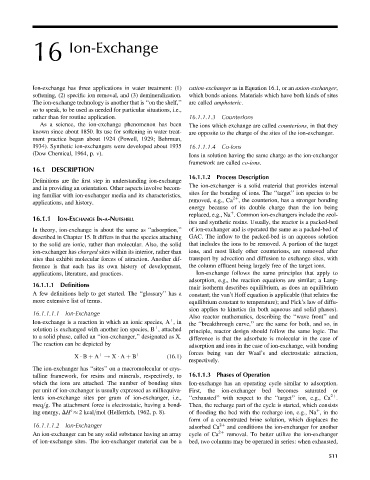Page 556 - Fundamentals of Water Treatment Unit Processes : Physical, Chemical, and Biological
P. 556
16 Ion-Exchange
Ion-exchange has three applications in water treatment: (1) cation-exchanger as in Equation 16.1, or an anion-exchanger,
softening, (2) specific ion removal, and (3) demineralization. which bonds anions. Materials which have both kinds of sites
The ion-exchange technology is another that is ‘‘on the shelf,’’ are called amphoteric.
so to speak, to be used as needed for particular situations, i.e.,
rather than for routine application. 16.1.1.1.3 CounterIons
As a science, the ion-exchange phenomenon has been The ions which exchange are called counterions, in that they
known since about 1850. Its use for softening in water treat- are opposite to the charge of the sites of the ion-exchanger.
ment practice began about 1924 (Powell, 1929; Behrman,
1934). Synthetic ion-exchangers were developed about 1935 16.1.1.1.4 Co-Ions
(Dow Chemical, 1964, p. v). Ions in solution having the same charge as the ion-exchanger
framework are called co-ions.
16.1 DESCRIPTION
16.1.1.2 Process Description
Definitions are the first step in understanding ion-exchange
The ion-exchanger is a solid material that provides internal
and in providing an orientation. Other aspects involve becom-
sites for the bonding of ions. The ‘‘target’’ ion species to be
ing familiar with ion-exchanger media and its characteristics,
removed, e.g., Ca , the counterion, has a stronger bonding
2þ
applications, and history.
energy because of its double charge than the ion being
replaced, e.g., Na . Common ion-exchangers include the zeol-
þ
16.1.1 ION-EXCHANGE IN-A-NUTSHELL
ites and synthetic resins. Usually, the reactor is a packed-bed
In theory, ion-exchange is about the same as ‘‘adsorption,’’ of ion-exchanger and is operated the same as a packed-bed of
described in Chapter 15. It differs in that the species attaching GAC. The inflow to the packed-bed is an aqueous solution
to the solid are ionic, rather than molecular. Also, the solid that includes the ions to be removed. A portion of the target
ion-exchanger has charged sites within its interior, rather than ions, and most likely other counterions, are removed after
sites that exhibit molecular forces of attraction. Another dif- transport by advection and diffusion to exchange sites, with
ference is that each has its own history of development, the column effluent being largely free of the target ions.
applications, literature, and practices. Ion-exchange follows the same principles that apply to
adsorption, e.g., the reaction equations are similar; a Lang-
16.1.1.1 Definitions
muir isotherm describes equilibrium, as does an equilibrium
A few definitions help to get started. The ‘‘glossary’’ has a constant; the van’t Hoff equation is applicable (that relates the
more extensive list of terms. equilibrium constant to temperature); and Fick’s law of diffu-
sion applies to kinetics (in both aqueous and solid phases).
16.1.1.1.1 Ion-Exchange
Also reactor mathematics, describing the ‘‘wave front’’ and
Ion-exchange is a reaction in which an ionic species, A ,in the ‘‘breakthrough curve,’’ are the same for both, and so, in
þ
solution is exchanged with another ion species, B , attached principle, reactor design should follow the same logic. The
þ
to a solid phase, called an ‘‘ion-exchanger,’’ designated as X. difference is that the adsorbate is molecular in the case of
The reaction can be depicted by adsorption and ions in the case of ion-exchange, with bonding
forces being van der Waal’s and electrostatic attraction,
X B þ A ! X A þ B þ (16:1)
þ
respectively.
The ion-exchanger has ‘‘sites’’ on a macromolecular or crys-
talline framework, for resins and minerals, respectively, to 16.1.1.3 Phases of Operation
which the ions are attached. The number of bonding sites Ion-exchange has an operating cycle similar to adsorption.
per unit of ion-exchanger is usually expressed as milliequiva- First, the ion-exchanger bed becomes saturated or
lents ion-exchange sites per gram of ion-exchanger, i.e., ‘‘exhausted’’ with respect to the ‘‘target’’ ion, e.g., Ca .
2þ
meq=g. The attachment force is electrostatic, having a bond- Then, the recharge part of the cycle is started, which consists
ing energy, DH8 2 kcal=mol (Helferrich, 1962, p. 8). of flooding the bed with the recharge ion, e.g., Na , in the
þ
form of a concentrated brine solution, which displaces the
16.1.1.1.2 Ion-Exchanger adsorbed Ca 2þ and conditions the ion-exchanger for another
An ion-exchanger can be any solid substance having an array cycle of Ca 2þ removal. To better utilize the ion-exchanger
of ion-exchange sites. The ion-exchanger material can be a bed, two columns may be operated in series: when exhausted,
511

